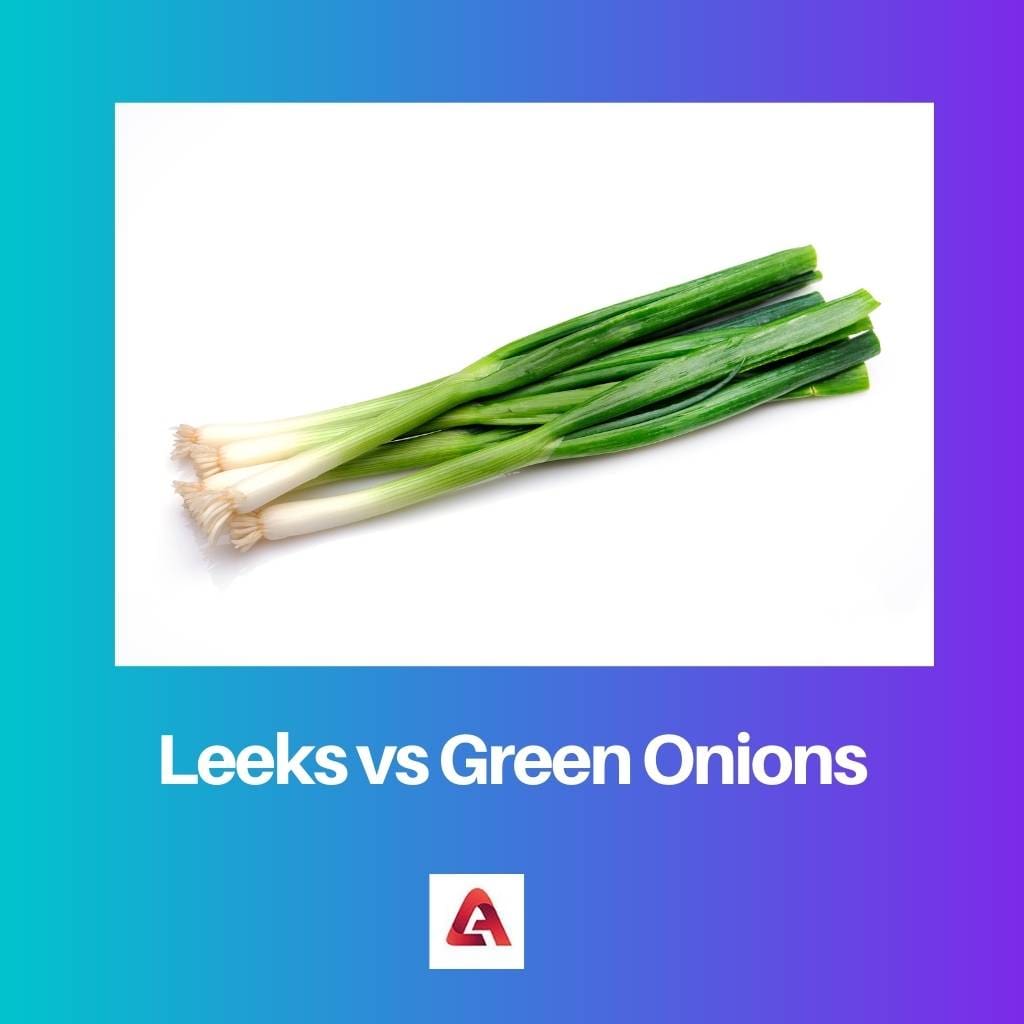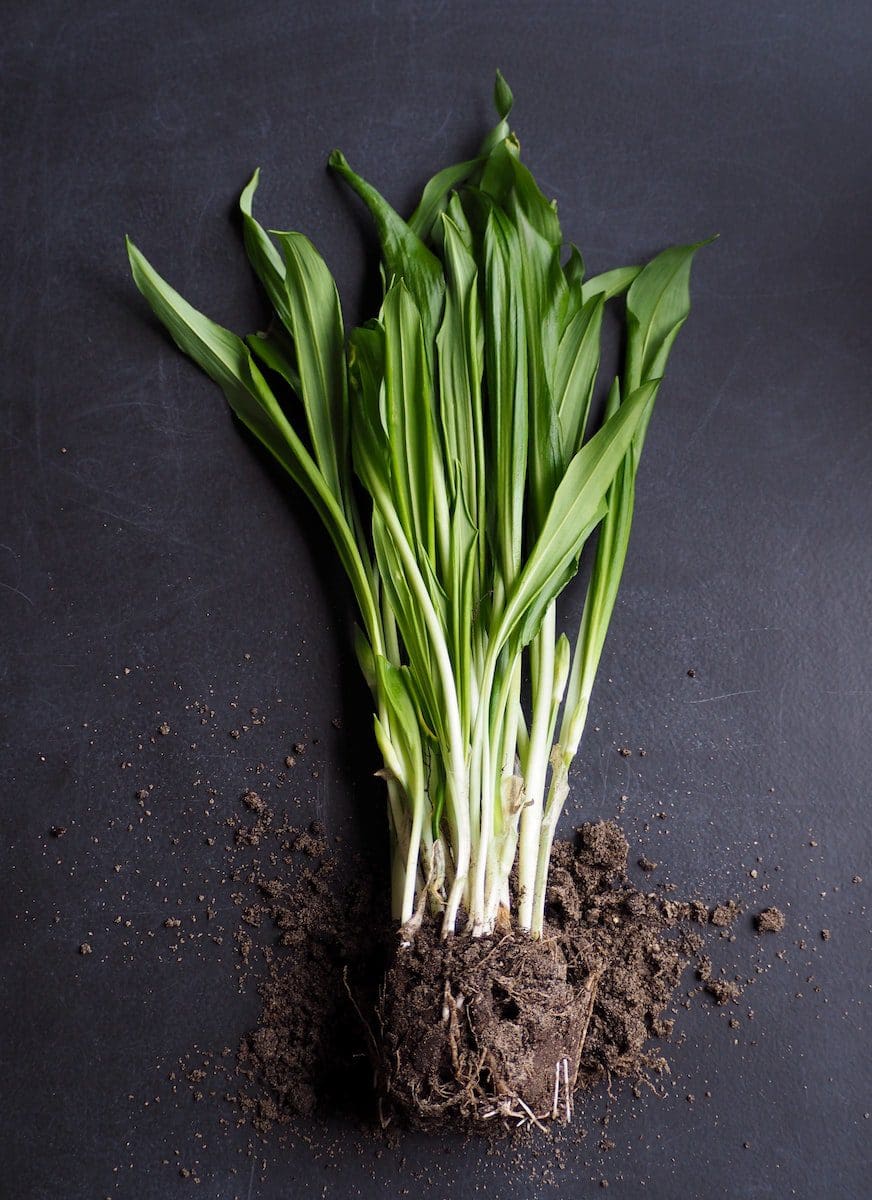People get confused between leeks and green onions. Both Leeks and green onions belong to the Amaryllidaceae, a herb family that also consists of chives and garlic.
Though they share the same family, the appearances of both Leeks and Green onions slightly differ, and their taste is somewhat similar.
Key Takeaways
- Leeks have a milder, sweeter flavor than green onions’ sharper taste.
- Green onions possess a thinner, hollow stem, while leeks feature a thicker, flat stem.
- Leeks require a longer cooking time due to their denser texture, whereas green onions cook quickly.
Leeks vs Green Onions
The difference between Leeks and Green onions is that both are different herbs. The botanical name for green onions is Allium fistulosum, while the botanical name of Leeks is Allium porrum. The appearance of Leeks is that of a large-sized green onion. The average height of Leeks ranges between two and three feet, while green onions can grow up to three feet as a plant.

Leeks are sweet in flavour and taste somewhat like onion. Leeks are said to have plenty of health benefits.
Leeks contain antioxidants and can also prevent cholesterol and blood pressure. Except for the leaves, the light green and white parts (the stem part) are used for the soups.
The Leeks are primarily used in soups and fried rice recipes.
Green onions are also known as Spring onions and sometimes it is known as Scallions. Interestingly, green onions are considered to contain cancer-preventing elements.
Green onions can be eaten raw, and they provide a good amount of Sulphur to the body. Green onions are used as a garnishing element in soups and pasta.
Comparison Table
| Parameters of Comparison | Leeks | Green onions |
|---|---|---|
| Appearance | Leeks contain thick dark green leaves in their top part and are light green and white in colour in the middle and its base part (the stem). | Green onions have a long stem that is fully light green in colour with a small bulb-like onion in its base. |
| Height | The height of Leeks ranges between two and three feet. | Green onions can reach a height of eighteen feet. |
| Growing conditions | Leeks are suitable for growing indoor and outdoor. They require less sunlight. | Green onions are also suitable for both indoor and outdoor planting. They require direct sunlight. |
| Consumption | The thick leaves are sliced off, and only the middle and base parts are used for consumption. Rarely, the leaves are used. | The entire vegetable is used for consumption. The white part gives an onion flavour, and the green part is used mostly for garnishing. |
| Health benefits | Leeks contain antioxidants and Vitamin K and help in controlling blood pressure and contain cancer-preventing agents. | Green onions help in lowering cholesterol and blood pressure. They provide antioxidants for the body. |
What are Leeks?
Leek is a type of onion that has a stem that is light green in the middle and white in the base part. Allium Porrum is the botanical name for Leeks. Occasionally, leeks are used as a substitute for green onions.
But in most cases, leeks are primarily used instead of green onions. The upper part of leeks has dark green leaves that are sliced off before using it for cooking purposes.
Some even consume the leaves of wild leeks. Leeks have a light flavour of onion and sweeten the dish, and it is used for side dishes such as creamy soups.
Leeks can go well with all herbs and spices in a dish and can give an aromatic flavour when served. Leeks tend to grow on open surfaces. In terms of planting, the seeds can be sowed in moisturized soil during the spring season.
Leeks can grow up to two to three feet. Leeks require a small amount of sun for their growth, so Leeks are ideal for indoor and outdoor planting.
Interestingly in Chinese culture, Leeks symbolize wealth and are consumed during the Chinese New Year. Another interesting fact is that Leek is a symbol of Wales.

What are Green Onions?
Green onions are a part of the Amaryllidaceae family. They are also known as Green onions and sometimes are called Scallions.
The stem or stalk is long in size, and a small bulb-like onion is found in the base part. Green onions taste more like a regular onion but have a less oniony odour.
Simply put, Green onions are pre-matured onions.
Green onions are used as a garnishing element in most foods, and sometimes they are sautéed along with other vegetables when preparing dishes like salads. They add flavours to the dish.
In terms of health benefits, Green onions consist of essential nutrients to maintain a healthy gut and also contains cancer-preventing agents. They can even aid in weight loss and is one perfect vegetable for daily consumption, and they can be grown in almost every season.
In terms of growing Green onions, they require more sunlight and take up to 4 to 6 weeks. Another method of growing Green onions is soaking the stem in a container of water without removing its bulb and roots.
Green onions growing in water takes less time when compared to growing them on the ground surface. Green onion’s shelf life depends on where it is stored. It can last up to one or two weeks in the refrigerator and two to three days on the shelf.

Main Differences Between Leeks and Green Onions
- The botanical name for Leek is Allium ampeloprasum, while the botanical name of green onion is Allium fistulosum.
- Leeks require less sunlight when compared to Green onions and can even be grown in partial shade. On the other hand, Green onions require direct sunlight. Both require moisturized soil.
- The growth span of Leeks is around 75 to 80 days, while Green onions can take up to 70 to 80 days to grow.
- The whole part of green onion, except for the roots, is used for consumption. On the other hand, only the stem and base part is used for consumption.
- Leeks give a mild flavour of onion with a hint of sweetness. On the other hand, green onions have a very light taste of onion and add flavour to the dish.

- https://link.springer.com/article/10.1023/A:1012547004545
- https://www.sciencedirect.com/science/article/abs/pii/S0007153685802552

The detailed comparison of leeks and green onions sheds light on their distinct appearances, tastes, and culinary uses. The facts about their growth and folklore add an interesting dimension to the knowledge about these herbs.
The article provides a clear understanding of the differences between leeks and green onions, along with their distinct nutritional benefits. It’s an enriching read overall.
The information about leeks and green onions being used in different cuisines is quite intriguing. It’s interesting to see how these herbs play a role in culinary traditions.
Leeks are known for their milder flavor and subtle onion taste, while green onions have a sharper taste. The article provides a comprehensive understanding of their differences and uses.
I agree, the overview about leeks and green onions is quite informative. The details about their role in different cuisines are quite interesting to know.
The description of leeks and green onions gives a good comparison of their nutritional benefits and culinary uses. It’s helpful to understand how they differ in taste and appearance.
The information about the cultural significance of leeks and green onions is quite fascinating. It adds a unique aspect to the understanding of these herbs.
The insights into the health benefits of leeks and green onions are quite valuable. It’s good to know how they contribute to overall well-being.
The explanations provided in the article offer a comprehensive understanding of the distinctions between leeks and green onions. It’s interesting to learn about their attributes and culinary uses.
The details about the uses and health benefits of leeks and green onions are quite valuable. It’s enriching to know how these herbs contribute to various cuisines and well-being.
The comparison table and detailed information help distinguish between leeks and green onions effectively. The article provides a thorough understanding of their differences and uses.
The facts about the growth and health benefits of leeks and green onions are quite fascinating. It’s important to understand the diverse elements of these herbs.
The detailed comparison gives a clear picture of how leeks and green onions differ. The focus on their nutritional aspects is quite insightful.
The explanation about leeks and green onions is detailed, and it’s interesting to learn how they can be used in different dishes. The emphasis on their health benefits adds more value to the information.
The information about leeks and green onions being used as substitutes is quite intriguing. It’s fascinating to see how these herbs have cultural significance in different regions.
Leeks and green onions belong to the same herb family, but they have some slight differences. The variance in taste and appearance is what sets them apart. The information provided gives a comprehensive insight into the differences between two.
The health benefits of leeks and green onions are noteworthy. It’s valuable to know how they contribute to lowering cholesterol, controlling blood pressure, and providing antioxidants to our bodies.
The comparison table is quite helpful in understanding the distinctions between leeks and green onions. It’s interesting to know how they differ in terms of appearance, height, and growing conditions.
The information about the nutritional benefits and uses of leeks and green onions is quite enlightening. The comparison and cultural details add to the overall value of the article.
The comparison of leeks and green onions in terms of growth, consumption, and health benefits is quite intriguing. It’s helpful to have a detailed understanding of these herbs.
The article gives a comprehensive overview of the distinctions between leeks and green onions. The insights into their uses and cultural associations are quite interesting to know.
The details about the interpretations of leeks and green onions in different cultures are quite interesting. It’s good to know how these herbs hold symbolic significance in various traditions.
The nutritional and cultural insights into leeks and green onions are quite enlightening. It’s valuable to understand their diverse roles in different contexts.
The distinction in the appearance, taste, and usage of leeks and green onions is quite clear from the detailed explanation. The comparison table provides a quick overview of their differences.
The details about the benefits and flavours of leeks and green onions are enlightening. It’s important to understand the nutritional aspects of these herbs.
The information about the growth and consumption of leeks and green onions is quite insightful. It’s good to know how they can be effectively used in various culinary dishes.